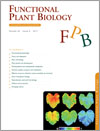
Functional Plant Biology
Volume 44 Number 6 2017
FP16164Use of multicolour fluorescence imaging for diagnosis of bacterial and fungal infection on zucchini by implementing machine learning
Remote sensing has become an essential tool in phenotyping and precision agriculture to minimise the impact of cultural management on environment and human health. Several imaging techniques are currently in use for the detection of plant stress, but the information generated requires of increasingly advanced mathematical tools. Multicolour fluorescence imaging appears as a promising tool as data provider to feed mathematical models classifying healthy and infected zucchini plants.
FP16362Photosynthetic acclimation to elevated CO2 concentration in a sweet pepper (Capsicum annuum) crop under Mediterranean greenhouse conditions: influence of the nitrogen source and salinity
An increased CO2 concentration in the atmosphere improves yield of the horticultural crops but its efficiency is reduced after long-term exposure. We studied the evolution of the sweet pepper crop response to CO2 enrichment in Mediterranean greenhouse conditions under different salinity levels. The study revealed the crop phase when high CO2 concentration acclimation occurs and, thus, the point when removal of the CO2 supply could improve its efficiency.
FP16048Annual patterns of xylem embolism in high-yield apple cultivars
Winter and spring are crucial periods for long-lived woody species of temperate regions because of the considerable impact on the plants’ water relations. In this study on high-yield apple cultivars, we show which climatic and species-specific factors are primarily responsible for the impairment of the water transport system in winter as well as its restoration in spring. Our findings contribute to the general knowledge about tree hydraulics but are also of relevance for fruit growers.
FP16048 Abstract | FP16048 Full Text | FP16048PDF (509 KB) | FP16048Supplementary Material (744 KB) Open Access Article
FP16285On the induction of injury in tomato under continuous light: circadian asynchrony as the main triggering factor
Unlike other species, tomato plants need to ‘sleep’ 8 h a day to remain healthy; that is, continuous light injures tomatoes. We experimentally tested many proposed explanations for this enigma and discarded all but one, which suggest that the presence of a light – normally a ‘day’ signal – when the internal circadian clock indicates ‘it’s night-time’ is central to this disorder: we call this conflict ‘circadian asynchrony’. These findings help in understanding the complex co-ordination between metabolism, light and time.
FP16365Morpho-physiological responses to dehydration stress of perennial ryegrass and tall fescue genotypes
Climate change will shift the adaptive regions of most forage grasses. We investigated the responses of two tall fescue genotypes and one perennial ryegrass to increasing drought and found that at the physiological and metabolic levels drought was imposed more slowly in tall fescue. Tall fescue may fit into future demands for forage grasses due to its good drought resistance.
FP16300Evaluation and application of a targeted SPE-LC-MS method for quantifying plant hormones and phenolics in Arabidopsis
The quantitation of plant hormones by LC-MS remains challenging because they belong to different chemical classes with contrasted analytical imperatives, and matrix effects often compromise reliable measurements. Here we present a technique based on accurate-mass LC-MS taking advantage of matrix elimination by solid phase extraction before analysis. This method is applied to Arabidopsis samples and as expected, shows that abscisic acid is accumulated under drought and that mutants affected in aspartate oxidase have an increased content in salicylate.
FP16314Endosperm-specific OsPYL8 and OsPYL9 act as positive regulators of the ABA signaling pathway in rice seed germination
Pyrabactin resistance-like (PYL) proteins were identified as receptors of the plant hormone ABA, but the functions of many PYLs remains to be elucidated. In this work, we determined that rice OsPYL8 and OsPYL9 are specifically expressed in the endosperms. Analyses of transgenic rice plants overexpressing OsPYL8 or OsPYL9 further showed that the two OsPYLs function as positive regulators of ABA signaling pathway in rice seed germination.
FP16293Proton and anion transport across the tonoplast vesicles in bromeliad species
Although Crassulacean acid metabolism (CAM) has been well studied in the family Bromeliaceae, the relationship between CAM activity and vacuolar organic-acid transport at night has not. We investigated ATP- and PPi-dependent proton transport in the tonoplast membrane vesicles of seven bromeliad species. We found that tonoplast ATP-driven H+ activity is greater than tonoplast PPi. Our results demonstrate a close correlation between CAM rhythm and the intrinsic properties of vacuolar membranes.



